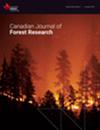Optimizing high-dimensional forestry for wood production and carbon sinks
IF 1.7
3区 农林科学
Q2 FORESTRY
引用次数: 0
Abstract
Our model for optimizing stand-level wood production and carbon sinks includes individual-tree models for forest growth, an advanced model for soil carbon, detailed wood production economy, and an intertemporal objective for the value of wood production and carbon sinks/emissions. Carbon stocks include aboveground biomass and carbon in forest soil and in wood products. Optimization of the management regime, rotations and thinning timing, and type and intensity are carried out by reinforcement learning. Including the social price of carbon causes a regime switch from continuous cover forestry to clear-cuts, postponed lighter thinning, and a longer rotation, and, with a high carbon price, to solutions with pure clear-cuts or solutions utilizing stands as pure carbon stocks. Carbon price has profound effects on stand values, and the bare land value may well exceed the value before a clear-cut. The total average carbon stock is maximized with harvest and a long rotation instead of "no harvesting". Bioenergy, carbon capture, and storage (BECCS) always increases the value of wood production but not necessarily the value of carbon sinks. With BECCS, increasing carbon stocks in trees and forest soil remains optimal.优化高维林业,促进木材生产和碳汇
我们用于优化林分级木材生产和碳汇的模型包括森林生长的单棵树模型、先进的土壤碳模型、详细的木材生产经济模型以及木材生产价值和碳汇/排放的跨期目标。碳储量包括地上生物量、森林土壤和木制品中的碳。管理制度、轮伐和间伐时间、类型和强度的优化是通过强化学习实现的。将碳的社会价格考虑在内,会使森林管理机制从连续覆盖转变为净伐、推迟轻伐和延长轮伐期,在碳价格较高的情况下,还会转变为纯净净伐或利用林分作为纯净碳储量的解决方案。碳价格对林分价值有深远影响,裸地价值可能远远超过砍伐前的价值。通过采伐和长期轮伐,而不是 "不采伐",可使总平均碳储量最大化。生物能源、碳捕集与封存(BECCS)总是能提高木材产量的价值,但不一定能提高碳汇的价值。有了生物能源、碳捕获与封存技术,增加树木和森林土壤中的碳储量仍然是最佳选择。
本文章由计算机程序翻译,如有差异,请以英文原文为准。
求助全文
约1分钟内获得全文
求助全文
来源期刊
CiteScore
4.20
自引率
9.10%
发文量
109
审稿时长
3 months
期刊介绍:
Published since 1971, the Canadian Journal of Forest Research is a monthly journal that features articles, reviews, notes and concept papers on a broad spectrum of forest sciences, including biometrics, conservation, disturbances, ecology, economics, entomology, genetics, hydrology, management, nutrient cycling, pathology, physiology, remote sensing, silviculture, social sciences, soils, stand dynamics, and wood science, all in relation to the understanding or management of ecosystem services. It also publishes special issues dedicated to a topic of current interest.

 求助内容:
求助内容: 应助结果提醒方式:
应助结果提醒方式:


